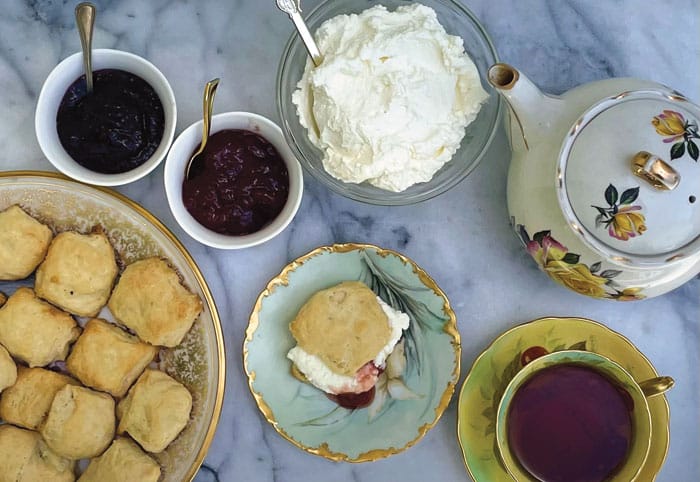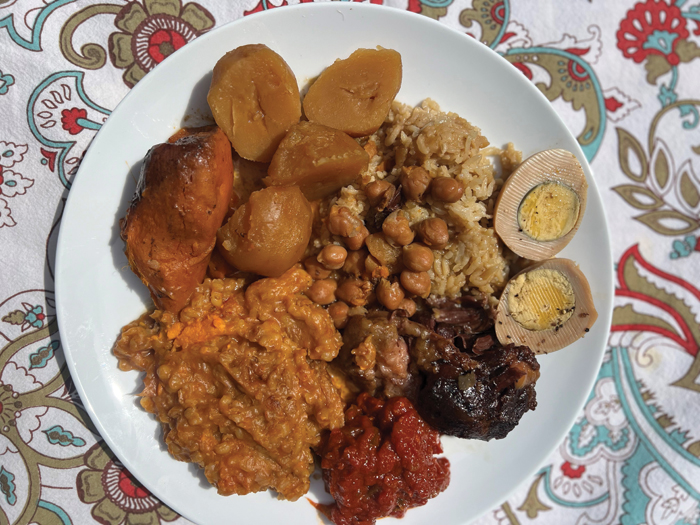Pure Gold—Shoham’s Bangle and A Pita Recipe
The recipe for pita is super simple. The recipe is basically four ingredients and making the dough was very simple.

The story of my seven-year-old mother at the airport in Baghdad has entered family legend. Before their departure, my grandmother Nana Aziza and my great aunts told her that she wouldn’t be allowed to take her jewelry to Israel. She reluctantly allowed them to remove her earrings, her necklace, her bangles and her anklets. But she was determined to hold onto her ring.
No amount of cajoling could convince her to take it off. She was adamant that it was her ring.
In May 1951, my grandparents made Aliyah to Israel. They packed one suitcase for themselves, my mother Shoham and her brothers David 6, Baruch 4, Kaduri 3 and Menashe 6 months.
When they arrived at the airport, there were two lines. My grandmother carried baby Menashe and walked with my mother to one line, my grandfather took the three boys to another. In the women’s section, two Arab women did a body search of my grandmother and checked Menashe’s diaper for smuggled jewels. They tore apart the baby’s bassinet. Then one of the women looked at my mother and said to my grandmother “Your daughter is wearing a ring.”
The woman refused to meet my mother’s eye and in angry defiance, my mother took off her ring and threw it at the woman.
My mother was born in the village of Al-Uzair, where my Nana Aziza’s father was the keeper of the Tomb of the Prophet Ezra, a shrine revered by the Jews and the Shiite Moslems, and where he had become wealthy by supplying the British Army. A few years later, my grandfather Aba Naji and Nana Aziza moved their family to Baghdad, where his family lived and where his father had been a respected doctor.
During Operation Ezra and Nehemiah, the nascent Israeli government airlifted 120,000 Jews from Iraq to Israel. They left one of the oldest communities in the Diaspora. They left the Tombs of the Prophets Ezekiel and Daniel. They left their synagogues and their businesses and their homes.
What do you do when you leave everything behind? You rebuild your family and you tell your stories to the next generation.
Now that my grandparents Nana Aziza and Aba Naji are no longer here to tell their stories it is incumbent on my generation to tell the stories.
My very talented cousin Sarah Sassoon has taken the story of my family leaving Iraq and woven it into a spellbinding tale, “Shoham’s Bangle.” Published by Kar-Ben Publishing and beautifully illustrated by artist Noa Kelner, this children’s book captures the sadness of leaving a home and the importance of remembering where we come from.
Like my mother, the Shoham in the book has to give up her favorite piece of jewelry, her gold bangle. The bangle that joins Nana Aziza’s many bangles to “make clink-clanking music when we chip-chop garlic and onions.” That cuts “perfectly round date cookies when we bake.” That “glitters golden in the sun when we pick figs from our garden.”

Before their departure from Iraq, the grandmother in the book bakes pita khibezz for the family to eat upon their arrival in Israel. She tells Shoham that it is like the matzoh that the Israelites baked in Egypt.
To find out about the wonderful surprise of Shoham’s Bangle, you’ll have to read the book.
—Sharon
I call Sharon’s cousin Sarah the smart girl. Whenever I am in Jerusalem, we meet up at her favorite coffee shop, Kadosh on Rechov Shlomzion HaMalka. When she published her beautiful children’s book “Shoham’s Bangle,” I was inspired to bake pita like Nana Aziza in the book.
Over the years, I have baked all kinds of breads. I have mastered the art of Challah. During COVID, I played around with sourdough, so that I could be like the cool kids. I have made Southern style biscuits and English scones.
Sharon’s Nana Aziza called pita by the Arabic name khibezz. I have made Moroccan khubz.
How hard could this be?
Sharon’s Nana Aziza called pita by the Arabic name khibezz. I have made Moroccan khubz.
The recipe for pita is super simple. The recipe is basically four ingredients and making the dough was very simple. Even forming the pita wasn’t a problem.
But to my disappointment, the pitas didn’t rise. (Only a few did, which was very exciting!) The pita tasted great. It was soft and fluffy but it didn’t have that nice pocket. This was more of a dipping bread. Sharon and I made a wonderful board with hummus and we all enjoyed the pita with the yummy black olive tapenade, green olive tapenade and artichoke tapenade that were so generously sent to us by Elyon Gourmet.
A little later, I went back to the drawing board to find out why my bread wasn’t as successful as I would’ve liked. I decided it was the yeast, definitely the yeast. It didn’t bloom properly and get all foamy. I had assumed that my kitchen was too cold that morning, but I should’ve known and thrown the yeast away and opened a new package.
I decided to give it another try and yes, this time the yeast bloomed and my pita blossomed.
Maybe you’ll have time to bake some soon.
—Rachel
Pita Recipe
1 tablespoon yeast
1 ¼ cups warm water
1 teaspoon salt
3-3 ½ cups flour
Preheat oven to 425°F.
- In the bowl of a stand mixer, dissolve yeast in water and let stand for about 5 minutes.
- Add salt and 1½ cups flour, then use the dough hook and beat to form a batter.
- Add the additional flour until a rough, shaggy dough is formed.
- On a floured surface, knead for 5 minutes until dough is smooth and elastic. If the dough is too sticky, add a little more flour.
- Divide the dough into six pieces for large pitas or ten for smaller pitas.
- Form dough into balls, then flatten with a rolling pin into ¼ inch thick discs. Using the palm of the hand works well.
- Make sure the dough is an even thickness as this is what helps the pita “puff’.
- Allow the pita to rest on lightly floured counter, covered with a tea towel for 30 minutes until slightly puffed. With a large spatula, flip the rounds of dough upside down on to a baking sheet.
- Bake 10-15 minutes until pita is a light golden color.
- Store at room temperature in a Ziploc bag for up to two days or in the freezer for a month
Rachel Sheff and Sharon Gomperts have been friends since high school. They love cooking and sharing recipes. They have collaborated on Sephardic Educational Center projects and community cooking classes. Follow them on Instagram @sephardicspicegirls and on Facebook at Sepha





